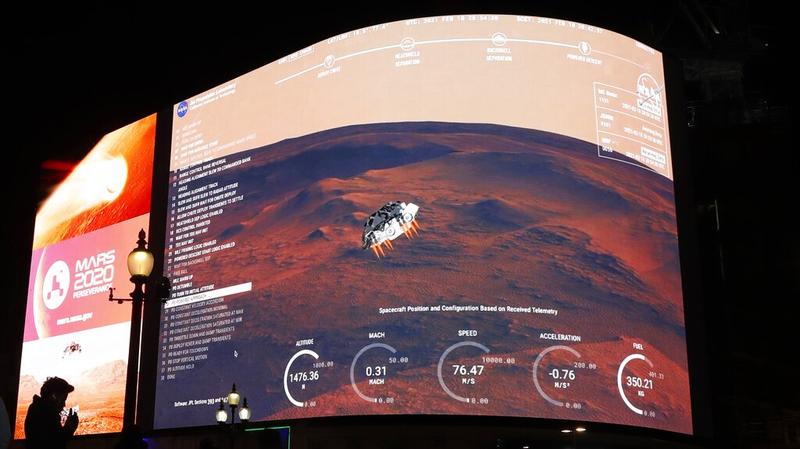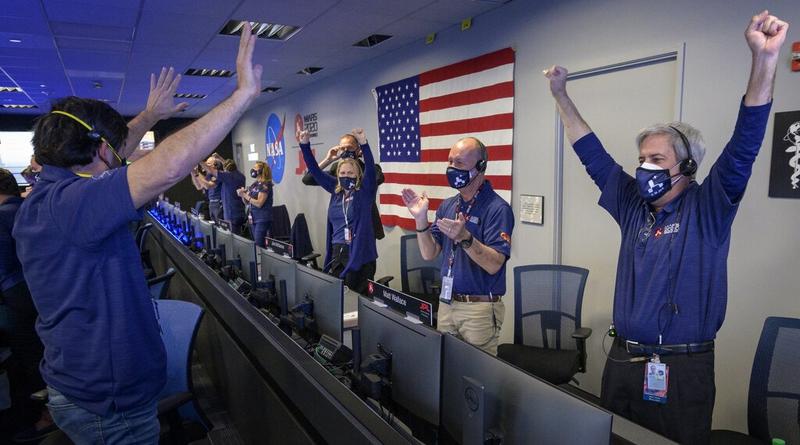 Images from NASA are streamed live showing the landing of NASA's Perseverance rover on Mars, shown on Piccadilly Lights in central London, on Feb 18, 2021. (ALASTAIR GRANT / AP)
Images from NASA are streamed live showing the landing of NASA's Perseverance rover on Mars, shown on Piccadilly Lights in central London, on Feb 18, 2021. (ALASTAIR GRANT / AP)
WASHINGTON - NASA's Perseverance rover touched down safely on Mars on Thursday, in search of signs of ancient life on the red planet.
Cheers erupted in mission control at NASA's Jet Propulsion Laboratory as controllers confirmed the rover, with the Ingenuity Mars Helicopter attached to its belly, completed its landing on Mars at around 3:55 pm EST.
The Perserverance rover will undergo several weeks of testing before it begins its two-year science investigation of Mars' Jezero crater, according to NASA. It will collect samples that will eventually be returned to Earth
The rover hit the top of the Martian atmosphere seven minutes before its touchdown, and executed the entry, descent, and landing (EDL) process, which was described by NASA as "seven minutes of terror."
ALSO READ: NASA launches new Mars rover to seek signs of past life
The rover sent back the first images of Mars after its touchdown.
About the size of a car, the 1,026-kilogram robotic geologist and astrobiologist will undergo several weeks of testing before it begins its two-year science investigation of Mars' Jezero crater, according to NASA.
Perseverance, which is the biggest, heaviest, cleanest, and most sophisticated six-wheeled robotic geologist ever launched into space, will search Jezero crater for signs of ancient life on Mars, and collect samples that will eventually be returned to Earth.
 This photo made available by NASA shows the an image sent by the Perseverance rover showing the surface of Mars, just after landing in the Jezero crater, on Feb 18, 2021. (PHOTO / NASA VIA AP)
This photo made available by NASA shows the an image sent by the Perseverance rover showing the surface of Mars, just after landing in the Jezero crater, on Feb 18, 2021. (PHOTO / NASA VIA AP)
Equipped with seven primary science instruments, the most cameras ever sent to Mars, and its exquisitely complex sample caching system - the first of its kind sent into space - Perseverance will scour the Jezero region for fossilized remains of ancient microscopic Martian life, taking samples along the way.
Perseverance was launched on July 30 last year from the Space Launch Complex 41 at Cape Canaveral Air Force Station in the US state of Florida. It arrived at the Red Planet after a 203-day journey traversing 472 million kilometers, according to NASA.
The rover is the third spacecraft that arrived on the red planet this month after the UAE's Hope probe and China's Tianwen 1 probe
It is the first rover to bring a sample caching system to Mars that will package promising samples for return to Earth by a future mission.
READ MORE: NASA spacecraft comes closer to Mars
"Perseverance is NASA's most ambitious Mars rover mission yet, focused scientifically on finding out whether there was ever any life on Mars in the past," said Thomas Zurbuchen, associate administrator for the Science Mission Directorate at NASA Headquarters in Washington.
"To answer this question, the landing team will have its hands full getting us to Jezero Crater - the most challenging Martian terrain ever targeted for a landing," he said.
 In this photo provided by NASA, members of NASA's Perseverance rover team react after receiving confirmation that the spacecraft has successfully touched down on Mars. At NASA's Jet Propulsion Laboratory in Pasadena, California, on Feb 18, 2021. (BILL INGALLS / NASA VIA AP)
In this photo provided by NASA, members of NASA's Perseverance rover team react after receiving confirmation that the spacecraft has successfully touched down on Mars. At NASA's Jet Propulsion Laboratory in Pasadena, California, on Feb 18, 2021. (BILL INGALLS / NASA VIA AP)
Perseverance is the fifth Mars rover sent by NASA to Mars, after Sojourner, Spirit, Opportunity, and Curiosity. It is also the largest and heaviest robotic Mars rover NASA has built.
The rover is the third spacecraft that arrived on the red planet this month after Hope probe, the first interplanetary mission from the United Arab Emirates, and Tianwen 1 probe, China's first Mars mission.


